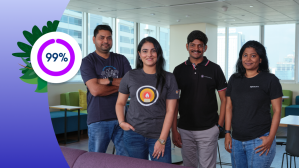If there is one way to describe how the world has felt the past couple of years it would be a combination of fast, surreal, and maybe even out of control, as life seems to be happening to us rather than with us. If there’s anything that we can appreciate from these times is that there are lessons we can learn from this disruption to grow and flourish even against uncertainty. One of those enlightenments is that technology must be purpose-built for a new world, and with it, leadership and talent must adapt to blaze new trails forward.
The rapid growth of technology during this time is one of many contributing factors to these collective feelings of acceleration and the relentlessness of keeping up.
To help employees feel more in control and that they’re working with a stronger sense of resolve and purpose, businesses must help their workforces become active participants in their work and career, rather than just trying to keep up with everything. This is perhaps the hardest part.
But what’s really important to understand is that we’re not going back to yesterday’s normal. The future is not what it used to be and as such, there is no playbook. Leaders, employees, must take this time to appreciate the incredible transformation needed and new opportunities abound to chart a new path forward. We must humanize innovation and all it takes to uncover opportunities for new value creation. We must foster a sense of community among the workforce, and now, always think beyond the next quarter, and invest in transformation two, three, and five years into the future, starting today.
Only then can businesses achieve economic success in a digital-first, work-from-anywhere world.
The Salesforce Economy is Open to Active Participation
At Salesforce, we’re actively driving toward these goals, for our workforce, and also for the people, and the greater economy, affected by this important work. The industry calls this the “Salesforce Economy.” In fact, IDC* expects the Salesforce Economy** (the combined influence of Salesforce and its partner ecosystem) to produce $1.6 trillion in new revenues for customers by 2026. More so, it’s expected to grow partner revenues to 3.5 times what they were in 2020.
The magic of the Salesforce economy though, doesn’t lie in the numbers or its incredible designation as an officially tracked economy. It comes to life through the people, our Trailblazers, who discover ways to create value for their organizations and businesses. While these numbers show tremendous economic success for the company and the ecosystem, it really shows the importance of what happens when you empower an entire community through shared purpose. What’s happening at Salesforce isn’t just about Salesforce. It’s about building a community bigger than any one thing. It’s about how every company and every person become the community and ultimately, the economy, to help transform organizations for the better.
Humanizing Transformation and Innovation
Innovating with purpose and humanity is fundamental to economic impact. Pandemic disruption taught us that the same factors that push digital transformation inside business are pushing day-to-day digital transformation too. Businesses must use technology to provide better experiences, skills, and capabilities for people.
I don’t believe that people join the Salesforce ecosystem***, I believe they become a part of a movement that is creating digital-first and human-first businesses. More so, the role they play is transformative and that desire to drive change is what really matters. For so long, and to be honest, still, companies were and are digitizing their businesses, shy of digitally transforming them. The Salesforce Economy, and this is what matters, is like the blockchain and the fountain of growth.
For those who are willing to learn, and also unlearn, it empowers people to bring to life new capabilities — and more so, become part of one big family.
The Significance of a Community Dedicated to Transformation
In its research, IDC predicted the Salesforce Economy will generate 9.3 million new jobs by 2026. That’s just around the corner. In a world that’s been so deeply focused on the narrative that technology is displacing jobs, here we see a starkly different story.
We can introduce new technologies for the next generation workforce, not at the expense of that workforce. Instead of displacing people, businesses have the ability to bring them to the forefront of technological innovation.
One of the special things about Salesforce is its capacity to bring out industry-leading technologies and at the same time, empower people to learn, or create the jobs that are needed to get in front of all these technologies. It empowers a community of learners to grow alongside the tech built to support them.
After what the workforce has experienced over the past year and a half, community is more important than ever. Only through community and shared learning can we humanize digital transformation — instead of fearing it.
Live Today Like It’s 2030
I think we can all appreciate that digital transformation has accelerated as a result of the pandemic. But that alone is not what matters moving forward. What matters is the fact that digital transformation accelerated by years and so did the need to make it, ironically, less digital and more meaningful.
Digital is a means. The question is, to what ends?
The decisions we make today around technology were on roadmaps for 2028 and 2029. Businesses woke up one day in 2020 and were transported eight years in the future. These decisions that once sat comfortably in the future are now right in front of our face — something that can be both terrifying and empowering.
I’m paying attention to the Salesforce Economy Study. It predicts out to 2026, and we must make decisions like 2026, and even 2030, is already here. Just like what we had to do back in March 2020, Salesforce and our ecosystem must tackle each day as though it’s five years in the future. Because if there is one thing we learned from this pandemic, it’s that we never know what tomorrow will bring.
So, what is my advice for businesses to grow and succeed in the future? Wake up like it’s 2030. The world needs, now more than ever, Trailblazers. Digital is just digital without purpose or vision or, you. The Salesforce economy isn’t so much about Salesforce, it’s about you and the role you play in shaping the future.
More information:
Read the IDC Salesforce Economy Study White Paper
Read the IDC Salesforce Economy Press Release
Explore the IDC Salesforce Economy Data in Tableau
*The International Data Corporation (IDC)
**IDC uses the term “The Salesforce Economy” to refer to the footprint of Salesforce and its partner ecosystem on the economy at large. This includes the revenues and jobs directly generated in the Salesforce customer base from the use of Salesforce and its partners cloud services, as well as jobs created indirectly in the economy by local spending by direct employees and Salesforce and its partners themselves.
***The Salesforce Ecosystem includes multiple stakeholders, all of which play an integral part in the Salesforce Economy. This includes the world’s top five consulting firms, all of which have prominent Salesforce digital transformation practices and independent software vendors (ISVs) that build their businesses on the Salesforce Customer 360 Platform and bring Salesforce into new industries.
IDC White Paper, sponsored by Salesforce, “The Salesforce Economic Impact,” doc #US48214821, September 20, 2021




















